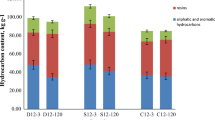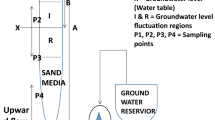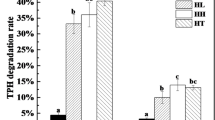Abstract
Oil spills during extraction and use are seriously threatening human health. Hence, effective bioremediation is a prerequisite for environmental and human well-being. In this study, bioremediation was performed by natural attenuation (NA), bioaugmentation (BA), and biostimulation (BS) microcosmic experiments. Gas chromatography and high-throughput sequencing were used to explore the changes in hydrocarbon degradation and bacterial community structure in different layers of contaminated soil, respectively. The results showed that the deep soil contained mainly C17‒C21 fractions. In 300 days, the degradation rates of soil total petroleum hydrocarbons in surface, middle, and deep soils were 99.87%, 96.04%, and 71.63% in the BA group; 99.75%, 95.73%, and 99.84% in the BS group; and 8.55%, 8.64%, and 9.84% in the NA group, respectively. Most of the petroleum hydrocarbon fractions were completely degraded by the end of remediation experiments. There were noticeable changes in the structure and relative abundance of soil bacteria in the different treatments compared to the original soil. Proteobacteria was the dominant phylum in all soil samples and Pseudomonas became the dominant genus in the BA group. In the BA and BS group, the germination rate of mung bean seeds was > 72.5% in all cases, which was six times higher than that of the NA group. Thus, bioremediation reduced the toxicity of contaminated soil in a shorter period of time than NA, and this study could act as a reference for treatment of contaminated soil in oil recovery areas.
Graphical Abstract







Similar content being viewed by others
Data Availability
All data generated or analyzed during this study are included in this published article.
References
Andrea Silva-Castro, G., Rodriguez-Calvo, A., Laguna, J., Gonzalez-Lopez, J., & Calvo, C. (2016). Autochthonous microbial responses and hydrocarbons degradation in polluted soil during biostimulating treatments under different soil moisture. Assay in pilot plant. International Biodeterioration & Biodegradation, 108, 91–98.
Bhattacharya, S., Das, A., Srividya, S., Prakruti, P. A., Priyanka, N., & Sushmitha, B. (2019). Prospects of Stenotrophomonas pavanii DB1 in diesel utilization and reduction of its phytotoxicity on Vigna radiata. International Journal of Environmental Science and Technology, 17, 445–454.
Bidja Abena, M. T., Li, T., Shah, M. N., & Zhong, W. (2019). Biodegradation of total petroleum hydrocarbons (TPH) in highly contaminated soils by natural attenuation and bioaugmentation. Chemosphere, 234, 864–874.
Chang, W. J., Dyen, M., Spagnuolo, L., Simon, P., Whyte, L., & Ghoshal, S. (2010). Biodegradation of semi- and non-volatile petroleum hydrocarbons in aged, contaminated soils from a sub-Arctic site: Laboratory pilot-scale experiments at site temperatures. Chemosphere, 80, 319–326.
Deng, Z., Jiang, Y., Chen, K., Gao, F., & Liu, X. (2020). Petroleum depletion property and microbial community shift after bioremediation using Bacillus halotolerans T-04 and Bacillus cereus 1–1. Frontiers Microbiology, 11, 353.
Devi, S. S. S. S. P., Jani, K., Sharma, A., & Jha, D. K. (2021). Bacterial communities and their bioremediation capabilities in oil-contaminated agricultural soils. Environmental Monitoring and Assessment, 194, 9.
Feng, X., Liu, Z., Jia, X., & Lu, W. (2019). Distribution of bacterial communities in petroleum-contaminated soils from the Dagang Oilfield, China. Transactions of Tian** University, 26, 22–32.
Gautam, P., Bajagain, R., & Jeong, S. W. (2020). Combined effects of soil particle size with washing time and soil-to-water ratio on removal of total petroleum hydrocarbon from fuel contaminated soil. Chemosphere, 250, 126206.
Geng, P., Ma, A., Wei, X., Chen, X., Yin, J., Hu, F., Zhuang, X., Song, M., & Zhuang, G. (2022). Interaction and spatio-taxonomic patterns of the soil microbiome around oil production wells impacted by petroleum hydrocarbons. Environmental Pollution, 307, 119531.
Gogoi, B., Das, I., Gogoi, M., Charingia, D., Bandyopadhyay, T., & Borah, D. (2022). Bioremediation of motor oil-contaminated soil and water by a novel indigenous Pseudomonas otitidis strain DU13 and characterization of its biosurfactant. 3 Biotech, 12, 68.
Hoang, S. A., Lamb, D., Seshadri, B., Sarkar, B., Choppala, G., Kirkham, M. B., & Bolan, N. S. (2021). Rhizoremediation as a green technology for the remediation of petroleum hydrocarbon-contaminated soils. Journal of Hazardous Materialls, 401, 123282.
Kwon, M. J., Lee, G., Hwang, Y. H., Lee, M., & Yang, J.-S. (2016). Effects of soil micro-particles and micropores on petroleum hydrocarbons released from contaminated soils during solvent extraction with ultrasound. Water, Air, & Soil Pollution, 227, 357.
Lee, Y. Y., Lee, S. Y., Lee, S. D., & Cho, K. S. (2022). Seasonal dynamics of bacterial community structure in diesel oil-contaminated soil cultivated with tall fescue (Festuca arundinacea). Interinational Journal Environmental Research and Public Health, 19, 4629.
Li, J., Zhang, J., Lu, Y., Chen, Y., Dong, S., & Shim, H. (2012). Determination of total petroleum hydrocarbons (TPH) in agricultural soils near a petrochemical complex in Guangzhou, China. Environmental Monitoring Assessment, 184, 281–287.
Li, J., Liu, Q., Sun, S., Zhang, X., Zhao, X., Yu, J., Cui, W., & Du, Y. (2022). Degradation characteristics of crude oil by a consortium of bacteria in the existence of chlorophenol. Biodegradation, 33, 461–476.
Liu, H., Gao, H., Wu, M., Ma, C., Wu, J., & Ye, X. (2020). Distribution characteristics of bacterial communities and hydrocarbon degradation dynamics during the remediation of petroleum-contaminated soil by enhancing moisture content. Microbial Ecology, 80, 202–211.
Liu, Q., Tang, J., Liu, X., Song, B., Zhen, M., & Ashbolt, N. J. (2019). Vertical response of microbial community and degrading genes to petroleum hydrocarbon contamination in saline alkaline soil. Journal of Environmental Sciences (china), 81, 80–92.
Liu, W., Luo, Y., Teng, Y., Li, Z., & Ma, L. Q. (2010). Bioremediation of oily sludge-contaminated soil by stimulating indigenous microbes. Environmental Geochemistry and Health, 32, 23–29.
Ma, W., & You, X. (2016). Numerical simulation of plant–microbial remediation for petroleum-polluted soil. Soil and Sediment Contamination: An International Journal, 25, 727–738.
Polyak, Y. M., Bakina, L. G., Chugunova, M. V., & Mayachkina, N. V. (2017). Effect of remediation strategies on biological activity of oil-contaminated soil - A field study. International Biodeterioration & Biodegradation, 126, 57–68.
RezaeiSomee, M., Shavandi, M., Dastgheib, S. M. M., & Amoozegar, M. A. (2018). Bioremediation of oil-based drill cuttings by a halophilic consortium isolated from oil-contaminated saline soil. 3 Biotech, 8, 229.
Ruffini Castiglione, M., Giorgetti, L., Becarelli, S., Siracusa, G., Lorenzi, R., & Di Gregorio, S. (2016). Polycyclic aromatic hydrocarbon-contaminated soils: Bioaugmentation of autochthonous bacteria and toxicological assessment of the bioremediation process by means of Vicia faba L. Environmental Science and Pollution Research, 23, 7930–7941.
Sarkar, J., Kazy, S. K., Gupta, A., Dutta, A., Mohapatra, B., Roy, A., Bera, P., Mitra, A., & Sar, P. (2016). Biostimulation of indigenous microbial community for bioremediation of petroleum refinery sludge. Frontiers in Microbiology, 7, 1407.
Shahi, A., Aydin, S., Ince, B., & Ince, O. (2016a). Evaluation of microbial population and functional genes during the bioremediation of petroleum-contaminated soil as an effective monitoring approach. Ecotoxicology and Environmental Safety, 125, 153–160.
Shahi, A., Aydin, S., Ince, B., & Ince, O. (2016b). Reconstruction of bacterial community structure and variation for enhanced petroleum hydrocarbons degradation through biostimulation of oil contaminated soil. Chemical Engineering Journal, 306, 60–66.
Shao**, K., Zhiwei, D., Bingchen, W., Huihui, W., Jialiang, L., & Hongbo, S. (2021). Changes of sensitive microbial community in oil polluted soil in the coastal area in Shandong, China for ecorestoration. Ecotoxicology and Environmental Safety, 207, 111551.
Silva-Castro, G. A., Rodelas, B., Perucha, C., Laguna, J., Gonzalez-Lopez, J., & Calvo, C. (2013). Bioremediation of diesel-polluted soil using biostimulation as post-treatment after oxidation with Fenton-like reagents: Assays in a pilot plant. Science of the Total Environment, 445–446, 347–355.
Singha, L. P., & Pandey, P. (2021). Rhizosphere assisted bioengineering approaches for the mitigation of petroleum hydrocarbons contamination in soil. Critical Reviews in Biotechnology, 41, 749–766.
Suja, F., Rahim, F., Taha, M. R., Hambali, N., Rizal Razali, M., Khalid, A., & Hamzah, A. (2014). Effects of local microbial bioaugmentation and biostimulation on the bioremediation of total petroleum hydrocarbons (TPH) in crude oil contaminated soil based on laboratory and field observations. International Biodeterioration & Biodegradation, 90, 115–122.
Smith, E., Thavamani, P., Ramadass, K., Naidu, R., Srivastava, P., & Megharaj, M. (2015). Remediation trials for hydrocarbon-contaminated soils in arid environments: Evaluation of bioslurry and biopiling techniques. International Biodeterioration & Biodegradation, 101, 56–65.
Sun, Y., **g, R., Zheng, F., Zhang, S., Jiao, W., & Wang, F. (2019). Evaluating phytotoxicity of bare and starch-stabilized zero-valent iron nanoparticles in mung bean. Chemosphere, 236, 124336.
Teng, Y., Feng, D., Song, L., Wang, J., & Li, J. (2013). Total petroleum hydrocarbon distribution in soils and groundwater in Songyuan oilfield, Northeast China. Environmental Monitoring Assessment, 185, 9559–9569.
Varjani, S., Pandey, A., & Upasani, V. N. (2021). Petroleum sludge polluted soil remediation: Integrated approach involving novel bacterial consortium and nutrient application. Science of the Total Environent, 763, 142934.
Varjani, S., Upasani, V. N., & Pandey, A. (2020). Bioremediation of oily sludge polluted soil employing a novel strain of Pseudomonas aeruginosa and phytotoxicity of petroleum hydrocarbons for seed germination. Science of the Total Environment, 737, 139766.
Varjani, S. J. (2017). Microbial degradation of petroleum hydrocarbons. Bioresource Technology, 223, 277–286.
Varjani, S. J., & Upasani, V. N. (2017). A new look on factors affecting microbial degradation of petroleum hydrocarbon pollutants. International Biodeterioration & Biodegradation, 120, 71–83.
Wang, Y. G., Wang, J. Q., Leng, F. F., & Chen, J. X. (2021). Effects of oil pollution on indigenous bacterial diversity and community structure of soil in Fushun, Liaoning Province, China. Geomicrobiology Journal, 38, 115–126.
Wei, Y., Chen, J., Wang, Y., Meng, T., & Li, M. (2021). Bioremediation of the petroleum contaminated desert steppe soil with Rhodococcus erythropolis KB1 and its effect on the bacterial communities of the soils. Geomicrobiology Journal, 38, 842–849.
Wolińska, A., Kuźniar, A., Szafranek-Nakonieczna, A., Jastrzębska, N., Roguska, E., & Stępniewska, Z. (2016). Biological activity of autochthonic bacterial community in oil-contaminated soil. Water, Air, & Soil Pollution, 227, 130.
Wu, B., Guo, S., & Wang, J. (2021). Spatial ecological risk assessment for contaminated soil in oiled fields. Journal of Hazardous Materials, 403, 123984.
Wu, M., Dick, W. A., Li, W., Wang, X., Yang, Q., Wang, T., Xu, L., Zhang, M., & Chen, L. (2016). Bioaugmentation and biostimulation of hydrocarbon degradation and the microbial community in a petroleum-contaminated soil. International Biodeterioration & Biodegradation, 107, 158–164.
Wu, M., Li, W., Dick, W. A., Ye, X., Chen, K., Kost, D., & Chen, L. (2017). Bioremediation of hydrocarbon degradation in a petroleum-contaminated soil and microbial population and activity determination. Chemosphere, 169, 124–130.
Wu, M., Wu, J., Zhang, X., & Ye, X. (2019). Effect of bioaugmentation and biostimulation on hydrocarbon degradation and microbial community composition in petroleum-contaminated loessal soil. Chemosphere, 237, 124456.
Xu, X., Liu, W., Tian, S., Wang, W., Qi, Q., Jiang, P., Gao, X., Li, F., Li, H., & Yu, H. (2018). Petroleum hydrocarbon-degrading bacteria for the remediation of oil pollution under aerobic conditions: A perspective analysis. Frontiers in Microbiology, 9, 2885.
Yu, W., Zheng, J., Song, Q., Zhao, C., Chen, C., Chen, H., Gao, C., & Song, J. (2019). Bio-char influenced indigenous microbial stimulation for oil contaminated soil remediation in Northwest China. Petroleum Science and Technology, 37, 1338–1345.
Funding
This work was supported by the National Natural Science Foundation of China (No. 51978189).
Author information
Authors and Affiliations
Contributions
All authors contributed to the study conception and design. Jieliang Nong participates in collection of sampling; experimental work; compilation of resulted data; writing—original draft; and writing—review and editing. Peng Peng: investigation; visualization; software; writing—original draft; and writing—review and editing. Jiayuan Pan: methodology; investigation; writing—original draft; and writing—review and editing. Taiming Shen: software and writing—review and editing. Qinglin **e: supervision, project administration, and funding acquisition.
Corresponding author
Ethics declarations
Competing Interests
The authors declare no competing interests.
Additional information
Publisher's Note
Springer Nature remains neutral with regard to jurisdictional claims in published maps and institutional affiliations.
Highlights
• The C17–C21 fraction poses the greatest threat to deep soils.
• Biostimulation was more effective than bioaugmentation in TPH biodegradation.
• Lack of nutrients is a major factor affecting petroleum hydrocarbon degradation.
• More structural diversity of microorganisms in the biostimulation group.
Rights and permissions
Springer Nature or its licensor (e.g. a society or other partner) holds exclusive rights to this article under a publishing agreement with the author(s) or other rightsholder(s); author self-archiving of the accepted manuscript version of this article is solely governed by the terms of such publishing agreement and applicable law.
About this article
Cite this article
Nong, J., Peng, P., Pan, J. et al. Effect of Bioaugmentation and Biostimulation on Hydrocarbon Degradation and Bacterial Community Composition in Different Petroleum-Contaminated Soil Layers. Water Air Soil Pollut 234, 189 (2023). https://doi.org/10.1007/s11270-023-06161-7
Received:
Accepted:
Published:
DOI: https://doi.org/10.1007/s11270-023-06161-7




